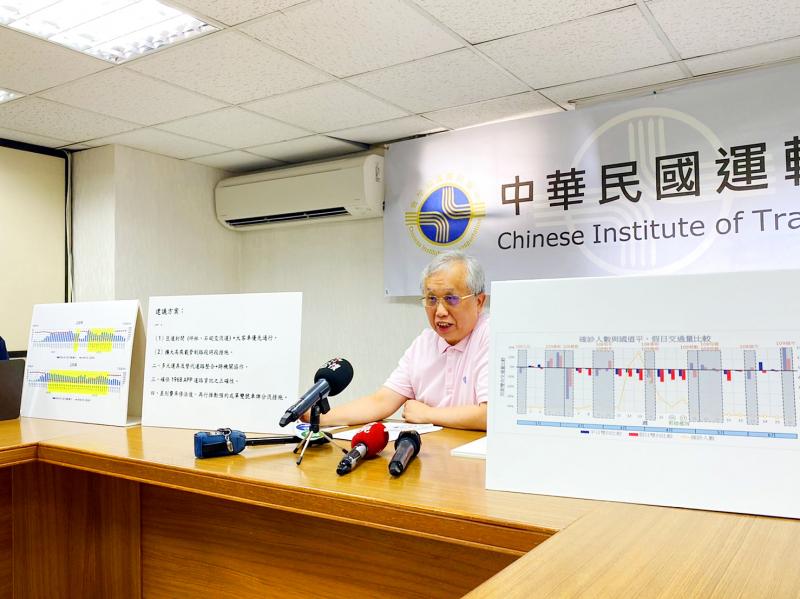A cap on freeway tolls should be lifted to allow transportation officials to devise a congestion pricing scheme that diverts freeway traffic to alternative routes more effectively on long holiday weekends, Chinese Institute of Transportation chairman Lin Liang-tay (林良泰) yesterday told a news conference at the Taipei-based institute.
Experts from the institute met with Freeway Bureau officials on Tuesday to discuss possible solutions to ease the congestion on the Chiang Wei-shui Freeway (National Freeway No. 5) after the freeway saw congestion for more than 30 hours over the Dragon Boat Festival long weekend last month.
Citing Freeway Bureau data, Lin said that the average driving speed on the freeway section between Taipei’s Nangang District (南港) and Shiding District (石碇) in New Taipei City was less than 60kph for more than 30 hours, and for about 20 hours the average speed was less than 20kph.

Photo: Hsiao Yu-hsin, Taipei Times
The key to easing congestion is to find out how to bring the most people to their destinations, rather than the most vehicles, he said.
When analyzing the traffic on the southbound lanes of the freeway on the first day of the holiday, experts found that 75 percent came from the Formosa Freeway (National Freeway No. 3), 15 percent from the Shiding Interchange and 10 percent from the Pinglin Interchange (坪林), he said.
At least 25 percent of the traffic on the freeway should be diverted to Highways No. 2 and No. 9, which are alternative routes to the freeway, he said.
Large passenger buses should be given priority access to the freeway to ensure that the maximum number of people, rather than vehicles, can access the freeway, he added.
Legislators should provide government officials with legal tools to regulate traffic, Lin said.
Using the Hsuehshan Tunnel (雪山隧道) on holidays only costs about NT$50 in tolls, but if the bureau wants to raise the tolls to help divert traffic, it cannot charge more than NT$100, so legislators need to amend the law to lift the cap on tolls, he said.
Asked if the ministry would consider raising tolls, Minister of Transportation and Communications Lin Chia-lung (林佳龍) said that the Freeway Bureau was carefully evaluating all the suggestions from transportation experts.
Tolls are just one tool that the ministry could use to relieve freeway congestion, he said, adding that others include the high-occupancy control (HOV) policy and arranging alternative routes.
“The Freeway Bureau will consider if asking motorists to pay more than twice the current toll would make a substantial difference to the traffic flow,” he said.
It would consult its data from previous years, as well as reviewing suggestions, before determining how to adjust freeway traffic flows during the Mid-Autumn Festival long weekend from Oct. 1 to Oct. 4, the minister added.
Meanwhile, other institute experts suggested that the bureau implement the HOV policy on all interchanges along Freeway No. 5, and increase the minimum number of people in a vehicle from three to four.
It should also consider enforcing a reservation system, where drivers would submit an online form about their estimated time of departure and planned routes, the experts said.

An essay competition jointly organized by a local writing society and a publisher affiliated with the Chinese Communist Party (CCP) might have contravened the Act Governing Relations Between the People of the Taiwan Area and the Mainland Area (臺灣地區與大陸地區人民關係條例), the Mainland Affairs Council (MAC) said on Thursday. “In this case, the partner organization is clearly an agency under the CCP’s Fujian Provincial Committee,” MAC Deputy Minister and spokesperson Liang Wen-chieh (梁文傑) said at a news briefing in Taipei. “It also involves bringing Taiwanese students to China with all-expenses-paid arrangements to attend award ceremonies and camps,” Liang said. Those two “characteristics” are typically sufficient

A magnitude 5.9 earthquake that struck about 33km off the coast of Hualien City was the "main shock" in a series of quakes in the area, with aftershocks expected over the next three days, the Central Weather Administration (CWA) said yesterday. Prior to the magnitude 5.9 quake shaking most of Taiwan at 6:53pm yesterday, six other earthquakes stronger than a magnitude of 4, starting with a magnitude 5.5 quake at 6:09pm, occurred in the area. CWA Seismological Center Director Wu Chien-fu (吳健富) confirmed that the quakes were all part of the same series and that the magnitude 5.5 temblor was

The brilliant blue waters, thick foliage and bucolic atmosphere on this seemingly idyllic archipelago deep in the Pacific Ocean belie the key role it now plays in a titanic geopolitical struggle. Palau is again on the front line as China, and the US and its allies prepare their forces in an intensifying contest for control over the Asia-Pacific region. The democratic nation of just 17,000 people hosts US-controlled airstrips and soon-to-be-completed radar installations that the US military describes as “critical” to monitoring vast swathes of water and airspace. It is also a key piece of the second island chain, a string of

The Central Weather Administration has issued a heat alert for southeastern Taiwan, warning of temperatures as high as 36°C today, while alerting some coastal areas of strong winds later in the day. Kaohsiung’s Neimen District (內門) and Pingtung County’s Neipu Township (內埔) are under an orange heat alert, which warns of temperatures as high as 36°C for three consecutive days, the CWA said, citing southwest winds. The heat would also extend to Tainan’s Nansi (楠西) and Yujing (玉井) districts, as well as Pingtung’s Gaoshu (高樹), Yanpu (鹽埔) and Majia (瑪家) townships, it said, forecasting highs of up to 36°C in those areas